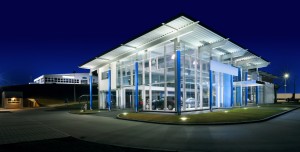Innovation and Collisions

Want me to mash something up?
As I’ve written on several occasions (here, here, and here), mashup thinking is often the driver behind breakthrough innovations. Mashup thinking is not the same as thinking out of the box. Rather, it’s thinking out of several different boxes.
Wheeled luggage is a good example. There’s a box called wheels. There’s another box called luggage. You take an idea from each box, mash them up, and create a third box called wheeled luggage. Now we can select an idea from yet another box called power supplies. We mash that up with wheeled luggage and we get yet another new product: self-propelled wheeled luggage.
Note that the originating ideas (wheels, luggage, power supplies) are not breakthrough ideas in and of themselves. Indeed, they’re rather mundane. It’s only by mashing them up that they become, new, different, and valuable.
How do you promote mashup thinking in your organization? The simple answer is collisions. You need to get people, ideas, and concepts to collide. Think of it as an atom smasher. When two atoms collide at high speed, they produce a very interesting array of new particles. You want to produce similarly productive collisions in your organization.
Here are some tips on creating productive collisions:
Diversity – let’s say you get two engineers to collide. That’s interesting but not usually productive. After all, they’re in the same box. The trick is to get two people from different boxes to collide. That requires diversity. This includes ethnic and geographic diversity. Some very innovative companies have found that putting together people from, say, Africa, Europe, South America, Japan and the USA can produce very interesting results. Age diversity – old people mixed with young – can also create productive collisions. For me educational diversity is equally important. Indeed, I tell my clients that one of the reasons they should hire me is because I don’t have an MBA. I think differently.
Seating arrangements – why do so many companies put engineers in one area, marketers in another, finance people in another and human resources folks in yet another? That practically guarantees that all collisions will be same-box collisions. Randomize your seating chart. You’ll be surprised.
Architecture – the way you organize your space can either promote or prevent collisions. Fewer bathrooms, fewer coffee stations, and fewer lunchrooms all promote collisions. Rather than providing lots of places to congregate, offer fewer. You’ll get larger congregations.
Policies – earlier this year, Marissa Mayer of Yahoo! announced that employees would need to come to the office. No more working from home all the time. The policy got a lot of pushback. But I’m sure that it also produced a lot more collisions.
Innovation: Signals and Processes

It’s a process.
Innovation is a two-part process. First, we need to create ideas. Second, we need to take those ideas and convert them into something practical and useful. In some ways, creating the idea is the easy part.
Too often, our efforts to innovate focus on one or the other but not both. We may develop lots of ideas on how to be more creative. Yet, creativity without discipline usually doesn’t produce innovation. The reverse is also true. Disciplined implementation processes don’t produce innovation unless we can feed creative ideas into the system.
One way to think about this is to understand the differences between signals and processes. To create innovative organizations, we’ll need both. Signals are about culture. Processes are about decisions.
Many organizations don’t actively foster innovation. They may talk about innovation but the culture doesn’t seek out and promote new ideas, new products, or new ways of doing business. The culture may be innovation resistant; it actively opposes change. Or it may simply be innovation neutral; it doesn’t oppose change but nor does it promote it. Change is hard. To succeed, the culture needs to actively foster change, not merely be neutral to it.
Let’s say we want to change our culture to actively promote change. That’s where signals come in. A signal lets our employees know that we’re changing our attitude toward change. Signals may be simple and obvious. It could be the way employees dress – Birkenstock Fridays! It could be the way work is organized – hackathons! It could be as simple as changing the seating chart or the lighting level or where the coffee stations are located.
Signals are useful but not sufficient. We also need processes that are baked into the culture. Let’s assume, for instance, that our new culture (with its new signals) creates lots of good ideas. Now we need a set of decision processes for evaluating new ideas and deciding which ones to invest in. As Rosabeth Moss Kanter points out classic financial metrics (ROI etc.) probably don’t apply. Classic financial metrics require predictability. Innovations aren’t predictable. We’ll need new processes.
Processes are useful but also not sufficient. You need processes to make the decisions to get the innovative work done. But you need signals to let people know that innovative work is acceptable and encouraged – and that new processes are emerging. As always, it’s the balance that counts.
Where You Stand Depends On Where You Sit

Stand by me.
I walk our dog, Bella, two or three times a day. I enjoy it almost as much as she does. I’ve also found that walking a dog is a great way to meet people. (If only I had known when I was single). It’s nice to meet the neighbors. But what’s frightening is that we all think alike.
As Bill Bishop pointed out in The Big Sort, we’ve sorted ourselves out by political viewpoints. Republicans live in Republican neighborhoods and Democrats live with Democrats. We don’t mix and mingle much. When we meet people, we tend to hear things that confirm rather than challenge our views. We live in echo chambers. Tom Friedman calls these monocultures as opposed to polycultures.
Monocultures can make you crazy. If you only read and hear ideas that you agree with, you’ll only reinforce pre-existing connections in your brain. You won’t create new connections. From everything I’ve read, the brain thrives on connections. The more, the merrier. Tom Friedman writes that polycultures are much more sustainable than monocultures. I suspect that a polycultural brain is much healthier than a monocultural brain.
We also know that mashup thinking is one of the best ways to stimulate innovation. You take ideas from different boxes and mash them up. This is not out-of-the-box thinking. It’s multiple-box thinking. Take X-rays and mash them up with computer processing and you get CT scans. Take phones and mash them up with computers and you get smart phones. Take MTV and mash it up with cop shows and you get Miami Vice.
The more we have monocultures, the less we’ll have mashups. The more we talk to people just like ourselves, the fewer innovations we’ll have. It’s by putting different things – products or ideas – together that we get innovation. We all have partially formed ideas. Only by interacting with people who have complementary ideas can we develop bright new innovations. (I suspect this is why Apple recently hired Angela Ahrendts from Burberry).
Given all this, I’m constantly amazed that companies deliberately create monocultures throughout their facilities. Engineers sit with engineers. Finance folks sit with finance folks. Marketers sit with marketers. Each little zone is a monoculture. People with the same outlook, backgrounds, education, and conditioning sit together. They don’t talk to people with complementary ideas. They talk to people with the same ideas.
If you want to stimulate innovation in your company, mix it up a bit. Even a random seating chart is probably better than a department-by-department arrangement. Group people with different interests and backgrounds together. Then change it every now and then to establish new patterns and innovative connections. Just remember, where you stand depends on where you sit.
Innovation – The Wide View

Showroom Online
Suellen used to work for a company founded on a great idea – there’s a lot of information out there and, if you can organize it, you can sell the organized information for a lot more than the raw data. The company, Information Handling Services (IHS), got its start by organizing and re-selling government information and military and technical specifications. (Today, the company offers a whole range of analytic and forecasting services as well).
Though IHS is very successful, I’d like to use one of their less successful products to illustrate an insight about innovation. In the early 90s, IHS identified an underserved market: home furnishing suppliers and designers. The information about home furnishings – furniture, carpets, upholstery, cabinets, fixtures, etc. – was highly fragmented. Designers who wanted to buy furnishings had an extremely difficult time identifying, locating, and evaluating their choices.
It seemed a perfect market for IHS. After all, they were experts at gathering and organizing information and making it easily searchable. And that’s just what they did. They contacted furnishings suppliers, gleaned the necessary information, and put it into an electronic system – called Showroom Online — that designers could search in a variety of ways. (For instance, “Find all Louis XIV style chairs that cost less than $1,000 and are available within six weeks”).
Then the IHS designers made a fateful technology decision. They chose to store and distribute the data on 12-inch LaserDiscs. LaserDiscs were among the first optical/laser, random-access storage and retrieval media. They were way ahead of their time. And that was the problem. Not many people had LaserDiscs, or understood them, or could afford them.
From what I remember, Showroom Online was a well-designed system. It just had one flaw. It didn’t fit.
I thought of Showroom Online as I was reading The Wide Lens, Ron Adner’s new book on innovation. Adner argues that, all too often, innovations fail because we take a narrow perspective. We focus on what we need to do. Adner calls this execution focus: “What does it take to deliver the right innovation on time, to spec, to beat the competition?”
Adner argues that execution focus is what causes failures like Showroom Online. We need to take a wider perspective. Specifically we need to recognize two types of risk:
Co-innovation risk – “…the extent to which the success of your innovation depends on the successful commercialization of other innovations.” (This seems to be what took down Showroom Online).
Adoption chain risk – “ the extent to which partners will need to adopt your innovation before end consumers have a chance to assess the full value proposition.”
This all relates to the issue of framing (which I’ve written about before). If you define your frame narrowly, you’ll miss a lot of important information. Other people – politicians, salespeople, teachers – may try to define the frame for you but you can also frame yourself. The trick is to take a step back, look around, and broaden your horizons. That’s important to you personally. It’s even more important to your innovation.
Innovation: Loosen Up, Tighten Up
I’ve written a lot about innovation but have yet to properly introduce Rosabeth Moss Kanter, one of our leading thinkers in innovation and change management. A professor at Harvard Business School, Kanter has written a string of books on innovation, incuding some of my favorites: Confidence: How Winning Streaks and Losing Streaks Begin and End and SuperCorp: How Vanguard Companies Create Innovation, Profit, Growth, and Social Good.
Today, I’d like to draw on concepts from one of Kanter’s articles in Harvard Business Review, “Innovation: The Classic Traps“. Kanter surveys a number of different traps but two, in particular, caught my attention, mainly because I’ve seen them myself.
The first is called controls too tight. All too often, companies use traditional metrics to judge the impact of non-traditional innovations. The problem is that traditional metrics — such as hurdle rates, ROI, or NPV — all require some type of track record to produce results that might be considered reliable.
The problem, of course, is that a truly innovative product has no track record. Kanter writes that companies often fall prey “… to the impulse to strangle innovation with tight controls — the same planning budgeting and reviews applied to existing businesses.” Kanter writes that the solution is to loosen up and add flexibility to your planning and control processes. This may include innovation funds and judicious exemptions for corporate requirements and timetables. Going a bit farther afield, you might also incorporate new financial metrics like real options analysis.
The second trap might be called connections too loose. The idea is that companies often isolate innovative new products and processes in organizational units that are physically and/or culturally isolated from the mainstream. Kanter points out that GM’s Saturn brand was established as a separate unit to pioneer new ways to design, build, and market midsize cars. While Saturn itself was innovative, the innovations didn’t have much impact on the rest of GM.
The same trap can affect established units as well. Kanter points out that CBS was once the largest broadcaster in the world and also owned the largest record company in the world. But MTV, not CBS, invented the music video. Kanter also writes that “… Gillette had a toothbrush unit (Oral B), an appliance unit (Braun), and a battery unit (Duracell) but lagged in introducing a battery powered toothbrush.”
Again, I think we can go a bit farther afield and identify similar disconnects among departments within a company. Engineering designs a product and then turns it over to manufacturing. That’s often a loose connection. If manufacturing experts participated in the design process (as they do at Apple), you might get products that are not only well designed but also easy to manufacture.
What to do? Kanter writes that “… companies should tighten the human connections between those pursuing innovation efforts and others throughout the rest of the business.” This requires good leadership, good communication skills, and a willingness to “convene discussions to encourage mutual respect rather than tensions and antagonism.” It may also require good architecture as in the example of Steelcase, which built ” a design enter that would force people to bump into one another….” (This is one of the reasons I think Marissa Mayer at Yahoo! is right to require people to work at the office).
So how do you stimulate innovation? While it’s not easy, a good first step is to loosen up you processes while tightening up your people-to-people connections.
